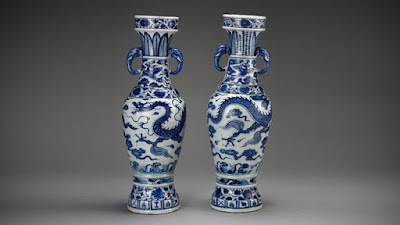Ancient Chinese Glass Yields To the Advent of Porcelain
A brief History: Ancient Chinese Glass Yields To the Advent of Porcelain
A curious thing occurred to me a while ago about the history of Chinese decorative arts when it comes to glass, why did they make so little of it over the centuries? Especially compared to other things such as jades, bronzes, porcelains, textiles, paintings and statuary carvings.The Chinese had glass and had first made it long before the Christian Era.
Despite having the knowledge of how to make glass starting in the Warring States Period 5th C. BC. Some argue glass was introduced to China by middle eastern traders in the form of beads, today recent studies indicated it may have been available well before this time as glass has been found inlaid into weapons predating this time period by several hundred years.
 |
| Warring States Period Glass Bi, Simulating White Jade |
 |
| Han Dynasty Mold Formed Cup |
 |
| Southern Song Qinbai Cup, 13th C Private Collection, Hamilton, Massachusetts see similar Victoria Albert Museum, entry c.45-1946 |
It wasn't until the 1700's, 800+ years later, that much of it was made in any quantity, so why did this skill remain dormant for basically a thousand years?
China clearly had the technical skills to make almost anything and in large quantity's and was light years ahead of Europe on almost all counts after the 10th C. when it came to manufacturing and chemistry. Skillful and astonishing bronzes had been made for 25 centuries. So what happened?
 |
| Fine Southern Song Bowl with Molded Decoration and applied copper rim. National Palace Museum Collection |
 |
| Southern Song Qingbai Bowl 12th C. Private Collection, Beverly, Massachusetts |
Soon the colors found in Qingbai examples were being likened to the colors found in softly colored jades. The region around the kiln area was even given the name "Raoyu" or "jade of Rao' ", Raozhou was the region where Jingdezhen was located.. With this kind of fascination and adoration for these wonderful objects, pottery and porcelain making in China was on an entirely new path that would in the end enchant Kings and noblemen of Europe and become the staple of every Imperial household.
 |
| Very Rare Song Dynasty Qingbai Kong form vase National Palace Museum Collection, Taiwan |
In some poems these pieces were actually referred to as "jade" and were nearly as, if not more valuable than the actual stone itself. "The first chill of midnight steals into my silken-netted cage and touches my jade pillow" -- from Intoxicated in Flower Shadows, by the Southern Song Poetess Li Qingzhou. She was in this poem talking about a porcelain pillow which were extremely rare and valuable even in this period.
It was from this beginning that China developed into the largest and for centuries the only producer of porcelain in the world.
To this day we refer to dishes, cups and plates as CHINA!
Feel free to email or call with any questions about your own Chinese porcelains or their values.
Thank you for visiting ~ Peter Combs
Gloucester, MA 978-283-3524
9SD2KF8AKGQ4


Comments
Post a Comment
If you have any questions or comments please send us a message. Or use the Contact Us tab at the top of the page.